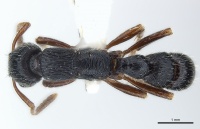Gnamptogenys alfaroi
| Gnamptogenys alfaroi | |
|---|---|

| |
| Scientific classification | |
| Kingdom: | Animalia |
| Phylum: | Arthropoda |
| Class: | Insecta |
| Order: | Hymenoptera |
| Family: | Formicidae |
| Subfamily: | Ectatomminae |
| Tribe: | Ectatommini |
| Genus: | Gnamptogenys |
| Species: | G. alfaroi |
| Binomial name | |
| Gnamptogenys alfaroi (Emery, 1894) | |
Known from mountane rain forest.
Identification
A member of the alfaroi subgroup (in the mordax species group). This species is a striking member of the mordax group due to its elongated, almost cylindrical body. Its relationship with other members of the mordax group is not clear. Mandibular dorsum smooth and shining with some punctulae; metacoxal spine present; subpetiolar process anteriorly projected ; gastric tergum 2 with basal one-half longitudinally costulate, the rest smooth and shining; disk of pospetiolar sternum smooth and shining; body black; legs and antennae brown. It is rarely collected. (Lattke 1995)
Keys including this Species
Distribution
Latitudinal Distribution Pattern
Latitudinal Range: 10.35° to -2.691°.
| North Temperate |
North Subtropical |
Tropical | South Subtropical |
South Temperate |
- Source: AntMaps
Distribution based on Regional Taxon Lists
Neotropical Region: Colombia, Costa Rica (type locality), Ecuador, Nicaragua.
Distribution based on AntMaps
Distribution based on AntWeb specimens
Check data from AntWeb
Countries Occupied
| Number of countries occupied by this species based on AntWiki Regional Taxon Lists. In general, fewer countries occupied indicates a narrower range, while more countries indicates a more widespread species. |

|
Estimated Abundance
| Relative abundance based on number of AntMaps records per species (this species within the purple bar). Fewer records (to the left) indicates a less abundant/encountered species while more records (to the right) indicates more abundant/encountered species. |

|
Biology
Castes
Nomenclature
The following information is derived from Barry Bolton's Online Catalogue of the Ants of the World.
- alfaroi. Ectatomma (Gnamptogenys) alfaroi Emery, 1894c: 145 (q.) COSTA RICA.
- Type-material: holotype queen.
- Type-locality: Costa Rica: Jimenez (A. Alfaro).
- Type-depository: MSNG.
- Combination in Gnamptogenys: Brown, 1958g: 227; Camacho, Franco, Branstetter, et al. 2022: 11.
- Status as species: Forel, 1899c: 9; Emery, 1911d: 45; Brown, 1958g: 227, 301; Kempf, 1972a: 111; Bolton, 1995b: 208; Lattke, 1995: 155; Lattke, et al. 2004: 342; Lattke, et al. 2007: 259 (in key); Lattke, et al. 2008: 77; Feitosa & Prada-Achiardi, 2019: 670; Camacho, et al. 2020: 457 (in key); Camacho, Franco, Branstetter, et al. 2022: 11.
- Distribution: Colombia, Costa Rica, Ecuador, Nicaragua, Panama.
Unless otherwise noted the text for the remainder of this section is reported from the publication that includes the original description.
Description
References
- Brown, W. L., Jr. 1958g. Contributions toward a reclassification of the Formicidae. II. Tribe Ectatommini (Hymenoptera). Bulletin of the Museum of Comparative Zoology 118: 173-362 (page 227, Combination in Gnamptogenys, page 301, see also)
- Cantone S. 2018. Winged Ants, The queen. Dichotomous key to genera of winged female ants in the World. The Wings of Ants: morphological and systematic relationships (self-published).
- Emery, C. 1894d. Studi sulle formiche della fauna neotropica. VI-XVI. Bull. Soc. Entomol. Ital. 26: 137-241 (page 145, queen described)
- Lattke, J. E. 1995. Revision of the ant genus Gnamptogenys in the New World (Hymenoptera: Formicidae). J. Hym. Res. 4: 137-193.
- Lattke, J.E., Fernández, F. & Palacio, E.E. 2007. Identification of the species of Gnamptogenys Roger in the Americas (pp. 254-270). In Snelling, R.R., Fisher, B.L. & Ward, P.S. (eds). Advances in ant systematics: homage to E.O. Wilson – 50 years of contributions. Memoirs of the American Entomological Institute 80: 690 pp.
References based on Global Ant Biodiversity Informatics
- Arias-Penna T. M. 2008. Subfamilia Ectatomminae. Pp. 53-107 in: Jiménez, E.; Fernández, F.; Arias, T.M.; Lozano-Zambrano, F. H. (eds.) 2008. Sistemática, biogeografía y conservación de las hormigas cazadoras de Colombia. Bogotá: Instituto de Investigación de Recursos Biológicos Alexander von Humboldt, xiv + 609 pp.
- Brown W. L., Jr. 1958. Contributions toward a reclassification of the Formicidae. II. Tribe Ectatommini (Hymenoptera). Bulletin of the Museum of Comparative Zoology 118: 173-362.
- Emery C. 1894. Studi sulle formiche della fauna neotropica. VI-XVI. Bullettino della Società Entomologica Italiana 26: 137-241.
- Emery C. 1896. Studi sulle formiche della fauna neotropica. XVII-XXV. Bullettino della Società Entomologica Italiana 28: 33-107.
- Emery C. 1911. Hymenoptera. Fam. Formicidae. Subfam. Ponerinae. Genera Insectorum 118: 1-125.
- Fernández, F. and S. Sendoya. 2004. Lista de las hormigas neotropicales. Biota Colombiana Volume 5, Number 1.
- Kempf, W.W. 1972. Catalago abreviado das formigas da regiao Neotropical (Hym. Formicidae) Studia Entomologica 15(1-4).
- Lattke J. E. 1995. Revision of the ant genus Gnamptogenys in the New World (Hymenoptera: Formicidae). Journal of Hymenoptera Research 4: 137-193
- Lattke J. E., F. Fernández, E. E. Palacio. 2004. Una nueva especie de Gnamptogenys (Hymenoptera: Formicidae) y comentarios sobre las especies del género en Colombia y Ecuador. Iheringia. Série Zoologia 94: 341-349.
- Lattke J. E., F. Fernández, T. M. Arias-Penna, E. E. Palacio, W. Mackay, and E. MacKay. 2008. Género Gnamptogenys Roger. Pp. 66-100 in: Jiménez, E.; Fernández, F.; Arias, T.M.; Lozano-Zambrano, F. H. (eds.) 2008. Sistemática, biogeografía y conservación de las hormigas cazadoras de Colombia. Bogotá: Instituto de Investigación de Recursos Biológicos Alexander von Humboldt, xiv + 609 pp.
- Longino J. et al. ADMAC project. Accessed on March 24th 2017 at https://sites.google.com/site/admacsite/

